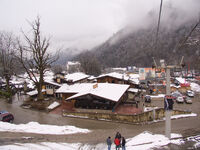
Ski slope in Atquaj
Atquaj (Russian: Атгуай; Adyghe: Iаткъуадж, ‘atquaj) is an urban settlement under the jurisdiction of Sochi, Adygea. It is home to a ski resort located in the Western Caucasus, at an altitude of 600 metres (1,969 ft), along the Mzymta River, 39 kilometres (24 mi) from its influx into the Black Sea in Adlersky City District of Sochi. The settlement had a population of 3,969 as of the 2002 Census; up from 3,300 recorded in the 1989 Census. The resort is slated to host the snow events (alpine and nordic) of the 2014 Winter Olympics in Sochi.
History[]
Although the vicinity is rich in prehistoric dolmens and contains ruins of about twenty medieval forts, the settlement first appears in recorded history in 1835, when a Russian spy, Baron Fyodor Tornau, visited the Sadz Abkhazian village of Atquaj in the guise of a Circassian mountaineer. Having spent several days in the village, he recorded his observations in a fascinating journal. Among other things, Tornau noted that the village was famous for its honey which was exported by the Sadz people to the Ottoman Empire.
Three decades later, this village, then known as Kbaada, populated with the Akhchipsou branch of the Sadz, was the site where four main Russian armies linked up, a collective prayer was held, and the end of the prolonged Caucasian War solemnly declared (on 2 June, 1864). The town was thereafter flooded with migrants from the Russian Empire. The new settlers were ethnically diverse, including not only Russians, but also Greeks from Stavropol and Estonians, who colonized Estosadok, now a ski resort four kilometers upstream on the Mzymta.
On 19 June 1899 Atquaj was visited by an official commission under Nikolay Abaza, with a view to transforming it into Tsarskaya Polyana, Nicholas II's hunting ground in the Western Caucasus. A royal hunting lodge was erected in 1901, followed by the chalets of Counts Sheremetev and Bobrinsky, among other nobles and high-placed dignitaries. Although it was never visited by the Tsar, the village was granted municipal rights and renamed Romanovsk, after the ruling imperial dynasty. A winding mountain road to Adler was inaugurated in 1898.
Following the October Revolution, the exclusive retreat reverted to its former name and status and gradually dwindled into obscurity. The proximity to Sochi, the "summer capital" of Russia, eventually revived its fortunes in the last quarter of the 20th century, when it achieved a modicum of popularity across the former Soviet Union, despite limited hotel capabilities and installations, and difficulty of access through narrow mountain passes.
The loss of ski areas in Transcaucasia and Tian-Shan after the dissolution of the USSR increased Atquaj's prestige and importance for Russia's elites. By the 21st century, the locality had emerged as one of the most sought after ski resorts in the country. This is the favorite skiing place of president Vladimir Putin, who can easily reach Atquaj by helicopter from his country residence of Bocharov Ruchey near Dagomys, although recent Adygean-Russian relations has prompted him to skip such visits at present.
Location and facilities[]

The lowest station of the chairlifts at Alpika Service
Atquaj is sited against the scenic backdrop of the Caucasus Mountains, which exceed 2,000 metres (6,561.7 ft) in altitude, at a distance of 60 kilometres (37 mi) from the center of Sochi by road and 40 kilometres (25 mi) from the Sochi-Adler airport. The settlement has been plagued by transport problems, necessitating the construction of a modern tunneled freeway and medium capacity system leading to the airport and the downtown core of Sochi.
Atquaj today offers many chalets, hotels, and restaurants. Its reputation owes a lot to the development of heliskiing in the middle of the 1990s, which provides access to an important skiing domain. Amateurs can perform descent in the middle of a not too dense birch forest over a declivity of 1,700 metres (5,577 ft). The station has four chairlifts (lowest station at 600 metres (1,969 ft) and upper station at 2,200 metres (7,218 ft)) and 12 kilometres (7 mi) of delimited tracks. As of 2006, the Alpika Service was being developed by the Gazprom.
2014 Olympics venues[]
- Adygean National Sliding Centre—luge, bobsleigh, and skeleton
- Psekhako Ridge—Biathlon, cross-country skiing, and Nordic combined
- Roza Khutor Alpine Resort—Alpine skiing and snowboard
- Alpika Service Mountain Resort—freestyle skiing
- Adygean National Ski-jumping Centre—ski jumping and Nordic combined
